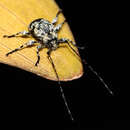Leptostylopsis perfasciatus: Brief Summary
provided by wikipedia EN
Leptostylopsis perfasciatus is a species of longhorn beetles of the subfamily Lamiinae. It was described by Lingafelter and Micheli in 2009.
- license
- cc-by-sa-3.0
- copyright
- Wikipedia authors and editors
Description
provided by Zookeys
Description. Length: 7.0-11.0 mm; width: 3.0-4.5 mm.
Head: Covered in dense, appressed, mostly white, pubescence throughout, yellow or ochraceous pubescence also present in some specimens. Narrow, median-frontal line from fronto-clypeal margin to between lower eye lobes, extending onto vertex. Short, glabrous frontal-genal line, extending from anterior tentorial pits along anterior margin of genae to base of mandible. Antenna: covered with dense, appressed, mottled, mostly white, off -white, pale ochraceous, and black pubescence; dark annulate at apex and base of most antennomeres. Last antennomere variably colored: either all dark, with apical 1/2 dark, or with dark annulae at base and apex. Antennae very long, typically extending beyond elytral apices by 5-6 antennomeres in males; extending beyond elytral apices by about 4-5 antennomeres in females. In both sexes, last antennomere shorter than penultimate. Antennal scape extending to posterior 1/4 of pronotum. Eye: lower eye lobe about as tall as gena below it; over 2 × height of upper eye lobe; lobes connected by 5-6 rows of ommatidia in most specimens. Upper eye lobes separated by little more than greatest width of scape. Mouthparts: frontoclypeal margin with fringe of mostly short, ochraceous or white pubescence extending about halfway to base of labrum (but longer at sides); clypeus without pubescence except at extreme base. Labrum covered at base with dense, mostly appressed, white or ochraceous pubescence with 8-10 long, suberect, translucent setae.
Thorax: Pronotum with slightly protuberant, broadly or narrowly rounded lateral tubercles with greatest projection slightly behind middle; with weakly raised dorsal tubercles of following arrangement: oval prominence at middle, partially denuded, surrounded by four smaller tubercles (two anterolateral and two posterolateral). Pronotum with slight anteromedial elevation at margin. Pronotum mostly covered in appressed, white, off -white, or ochraceous pubescence (or some combination), with dark, broad central region with less dense and translucent pubescence revealing reddish-brown integument. Small, dark macula present on anterior margin on each side, opposite upper eye lobe, and at middle of anterior margin (occasionally indistinct and not separate from large middle dark region). Pronotum with slight constriction before anterior and posterior margins, constrictions (particularly posteriorly) lined with row of separate, large punctures. Smaller punctures scattered over pronotal disk, some obscured by pubescence. Prosternum smooth, impunctate, covered with uniform, appressed, white or off -white pubescence. Prosternal process broad between procoxae, about 0.8 × width of procoxa in most specimens. Scutellum moderately white or ochraceous pubescent (with sparse pubescence at sides); broadly rounded posteriorly. Mesosternum smooth, impunctate, covered with uniform, appressed, white or off -white pubescence, less dense on anterior 1/3 which is deeply constricted. Mesosternal process between mesocoxae very broad, separating mesocoxae by about 1.3 × width of mesocoxa. Metasternum and lateral thoracic sclerites with appressed, white or off -white pubescence. Elytra: boldly covered with white, off -white, and ochraceous pubescence with less dense regions of translucent and black setae forming dark maculae at middle of epipleuron, extending to elytral disk, postmedially, extending from near suture to edge of disk, and less distinctively at apical 1/4. Small patches of black pubescence present on many tubercles mostly along costae and suture. Tubercles at base of elytra most prominent, forming weak crests. Humeri projecting moderately, without black macula at anterior margin. Epipleuron poorly defi ned; with white or ochraceous pubescence throughout except for dark macula at middle extending onto disk. Elytral apex angulate, with outer apical angle much more produced posteriorly than sutural angle. Legs: mostly uniformly pubescent with white or off -white appressed hairs; apex and basal 1/3 of tibiae annulate due to less dense, translucent, and black pubescence exposing darker integument. Tibiae approximately equal in length to femora; hind legs much longer than forelegs; metafemora extending to about middle of ventrite 5. Tarsi dark and unicolorous, coated with short, sparse, appressed, mostly translucent pubescence.
Abdomen: Ventrites covered with appressed, white or off -white pubescence. Fifth ventrite of females only 1.5 × broader than long, narrowed and extended at middle, with a glabrous midline at base, extending toward apex for 1/3 or more of overall length.
- bibliographic citation
- The genus Leptostylopsis of Hispaniola (Coleoptera, Cerambycidae, Acanthocinini)
Distribution
provided by Zookeys
Distribution. This widespread, endemic Hispaniolan species occurs throughout the Dominican Republic (Map 11).

